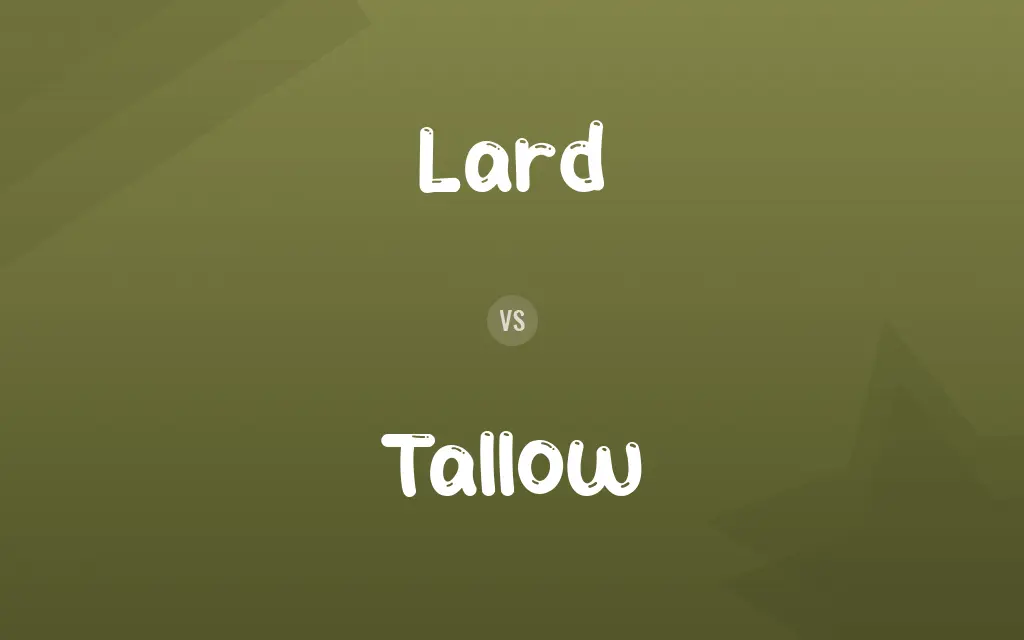Lard vs. Tallow: Difference and Comparison
Edited by Muazma Batool — By Muneeza Rehman — Published on March 2, 2024
Lard is rendered pork fat, used for cooking and baking, offering a mild flavor and tender texture. Tallow is rendered beef or mutton fat, known for its high smoke point and use in frying, as well as in soap and candle making.

Difference Between Lard and Tallow
Lard and tallow are both animal fats rendered from pork and beef or mutton, respectively. Lard, derived from pork fat, is celebrated for its ability to create flaky pastries and for its relatively neutral flavor, making it a favorite in both savory and sweet cooking applications. It's particularly valued in baking for the tender, flaky texture it imparts to pie crusts and pastries. Tallow, on the other hand, comes from the fat of beef or mutton and is noted for its high smoke point, making it suitable for high-heat cooking methods like frying. Tallow has a more distinct flavor compared to lard and is also used outside the kitchen in the production of soap and candles due to its hardening properties.
Muneeza Rehman
Mar 02, 2024
Both fats contribute to the richness and moisture of dishes but vary in their culinary uses based on their flavor profiles and melting points. Lard is softer at room temperature, which makes it easier to incorporate into doughs and batters. Tallow, being harder, is better suited for frying and sautéing, where its high smoke point is advantageous.
Muneeza Rehman
Mar 02, 2024
In terms of health, both lard and tallow have been reconsidered in recent dietary discussions. Once shunned for their saturated fat content, they are now often preferred over hydrogenated oils and trans fats found in many processed foods. However, moderation is key, as with all fats.
Muneeza Rehman
Mar 02, 2024
The choice between lard and tallow can depend on the desired outcome in cooking or baking, as well as personal dietary preferences. While lard brings a delicate, flaky texture to baked goods, tallow is prized for its ability to enhance the flavor and texture of fried foods.
Jonathan
Mar 02, 2024
Lard vs. Tallow Comparison Chart
Use outside Cooking
Limited to some culinary applications
Soap and candle making, industrial uses
Muneeza Rehman
Mar 02, 2024
Health
High in monounsaturated fats, vitamin D
Rich in saturated fats, vitamins A, D, E, K
Muneeza Rehman
Mar 02, 2024
Culinary Preference
Preferred for tender and flaky baked goods
Chosen for enhancing flavor in fried foods
Nolan
Mar 02, 2024
Lard vs. Tallow Definitions
◉Lard
Often used in traditional recipes for its unique properties.
Traditional pastry recipes often call for lard for its moisture and texture.
Muneeza Rehman
Feb 27, 2024
◉Tallow
Rendered fat from beef or mutton, used in cooking and non-edible products.
Tallow was used for deep frying, giving the food a rich taste.
Levi
Feb 27, 2024
◉Lard
Contains monounsaturated fats, considered healthier than trans fats.
Lard is now recognized for its natural fat content and vitamin D.
Muneeza Rehman
Feb 27, 2024
◉Tallow
Has a high smoke point, making it ideal for frying.
Frying chips in tallow enhances their crispiness and flavor.
Elijah
Feb 27, 2024
◉Lard
Can be used to fry and sauté, adding richness to dishes.
He fried the potatoes in lard for added flavor.
Muneeza Rehman
Feb 27, 2024
◉Tallow
Utilized in making candles and soaps due to its hardening properties.
Handmade soaps often contain tallow for its skin-nourishing benefits.
Kaitlyn
Feb 27, 2024
◉Lard
A type of fat rendered from pork, used in cooking and baking.
She used lard to make her pie crusts exceptionally flaky.
William
Feb 27, 2024
◉Tallow
Rich in saturated fats and fat-soluble vitamins.
Tallow is appreciated for its content of vitamins A, D, E, and K.
Olivia
Feb 27, 2024
◉Lard
Known for its mild flavor, making it versatile for various dishes.
Lard was added to the refried beans for a creamy texture.
Leo
Feb 27, 2024
◉Tallow
Offers a distinct flavor to dishes, especially fried foods.
The tallow added a noticeable depth of flavor to the beef stew.
Muneeza Rehman
Feb 27, 2024
◉Tallow
Hard fat obtained from parts of the bodies of cattle or sheep, used in foodstuffs or to make leather dressing, soap, and lubricants, and formerly used to make candles.
Muneeza Rehman
Feb 27, 2024
◉Lard
To enrich or lace heavily with extra material; embellish
Larded the report with quotations.
Muneeza Rehman
Feb 27, 2024
Lard vs. Tallow Frequently Asked Questions
Is lard healthier than tallow?
Both fats have their health considerations; lard is higher in monounsaturated fats, while tallow is rich in saturated fats and fat-soluble vitamins. Moderation is key.
Muneeza Rehman
Mar 02, 2024
Can I substitute lard for tallow in recipes?
Yes, but consider the recipe's desired flavor and texture. Lard is better for baking, while tallow suits frying and high-heat cooking.
Muneeza Rehman
Mar 02, 2024
Can vegetarians use lard or tallow?
No, both lard and tallow are animal products and not suitable for a vegetarian lifestyle.
Lucas
Mar 02, 2024
Why is tallow used in soap making?
Tallow hardens and stabilizes soap, giving it a smooth texture and extending its shelf life.
Kaitlyn
Mar 02, 2024
How do I render lard or tallow at home?
Both can be rendered by slowly melting and straining the fat from pork or beef trimmings, then cooling it to solidify.
Muneeza Rehman
Mar 02, 2024
Is there a taste difference between lard and tallow?
Yes, lard has a milder, more neutral flavor, while tallow has a stronger, more distinct taste, influencing the flavor profile of dishes.
Leo
Mar 02, 2024
Why were lard and tallow replaced by vegetable oils in many kitchens?
Concerns over saturated fat led to a shift towards vegetable oils, though recent trends favor natural animal fats for their flavor and lack of trans fats.
Nolan
Mar 02, 2024
What is the main difference between lard and tallow?
The main difference lies in their sources and applications: lard is rendered pork fat used primarily in baking for its mild flavor, while tallow is rendered beef or mutton fat, valued for frying due to its high smoke point.
Muneeza Rehman
Mar 02, 2024
Can lard and tallow be stored at room temperature?
For short periods, but for long-term storage, refrigeration is recommended to prevent rancidity.
Leo
Mar 02, 2024
Are lard and tallow sustainable?
They can be considered sustainable, especially when sourced from grass-fed, responsibly raised animals, utilizing parts of the animal that might otherwise be discarded.
William
Mar 02, 2024
Content Creators
Written by
Muneeza RehmanAt Comparisons.wiki, Muneeza skillfully navigates the vast sea of information, ensuring clarity and accuracy as the lead content editor. With a keen eye for detail, she curates every comparison to enlighten and engage readers.
Edited by
Muazma BatoolAs a content editor, Muazma Batool is not just a grammar guru but a creative mastermind who breathes life into every word. With an eagle eye for detail and a passion for storytelling, she transforms bland text into engaging content that captivates audiences and drives results.


































